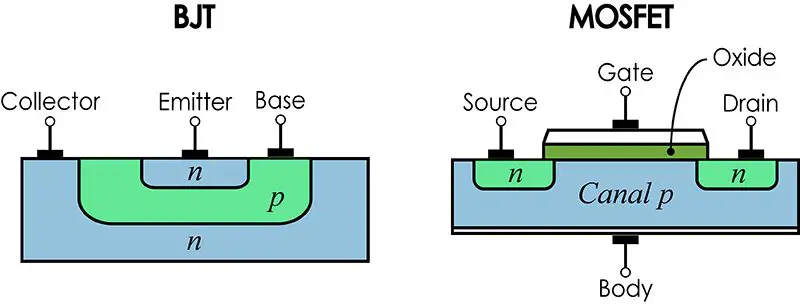

Functionally what is happening is that the electrostatic field of the gate is impinging on and affecting the resistance of the source-to-drain channel of the device (hence the term "field-effect transistor"). In contrast, the MOSFET is described as a voltage-controlled device, because its output current varies as a function of a small voltage applied to its gate. Because of this, the BJT is often described as a current-controlled device. The BJT varies its output current (defined here as the current flowing through the device from emitter to collector or vice versa) according to its base drive current multiplied by its current gain (hFE). Peruse this menu of solid-state, three-terminal, high-power devices and you'll see that each one controls the load in a different manner. The entrée list includes not only popular high-power transistors like MOSFETs, BJTs, and IGBTs, but also more exotic thyristor fare like Triacs and SCRs (for the restricted palate of AC-only or pulsating DC diets, which we will address in a future article).Īnd, of course, there are the requisite side dishes like ultrafast and Schottky rectifiers (no power design is complete without them, but that's a future article as well). Having your load characteristics well-defined means that you are ready to explore the menu of choices for driving your load. DC characteristics (and even potential fault characteristics) of your load Reactive parameters of your load (load inductance and load capacitance)

Succinctly put, there are three key performance parameters that help us understand which power transistor technology might best fit your power stage design: max operating voltage, max operating current, and max switching frequency.įirst thing first you have to decide what amount of power your system will need and for taht you ahev to decide:

Among them are the magnitude of current your particular load requires, the desired voltage to be applied across the load to achieve that current, and the maximum rate of change of current (dI/dt) and voltage (dV/dt) required. There are several considerations that will steer your choice of power transistor technology. You have a load through which you wish to drive current, and the state of that current flow (either fully on, fully off, or at some predetermined intermediate level) is a function of a signal delivered to the control terminal of the power semiconductor device. Keep in mind that varying the current through the load in a controlled manner is the primary function (the raison d'être, if you please) of any power semiconductor device. But that approach could lead us away from the real point, which is how the device is controlled to vary the load current. PART 1 - Gate or base / Channel or junctionĬhannels or junctions? How many? What type? These and other aspects of the internal device geometry and construction might be one way of looking at power semiconductors, as they are indeed different for the different types of solid-state power devices. You will need to clearly define your design criteria and approach first, then you can begin to evaluate the advantages and trade-offs of the various available power semiconductors. Finall, the operating frequency is important as well. The load power modulation technique will also be important and that could be linear, switching control or static. For example, the area of your application that could be motor control, power supply or maybe audio amplifiers and that will influence your choice. The answer it's valid, nonetheless, as the selection is truly dependent on a very wide variety of factors and aspects for the project you want to design. The answer is not straightforward, I would say: “ It depends.” And yes, taht's not a very informative or satisfying response but let me explain. As a designer you will have to determine whether to use BJTs or MOSFETs in your application power stage? Or should the designer use IGBTs? Would they work in the design? Would they be better? So there are several choices, but which is the best? If you always wondered which power transistor you should use for your circuits, in this article we will see all the main differences between the IGBT, the BJT and of course, the MOSFFET.


 0 kommentar(er)
0 kommentar(er)
